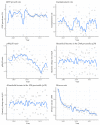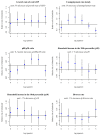How Does Economic Inequality Affect Infanticide Rates? An Analysis of 15 Years of Death Records and Representative Economic Data
- PMID: 31574941
- PMCID: PMC6801423
- DOI: 10.3390/ijerph16193679
How Does Economic Inequality Affect Infanticide Rates? An Analysis of 15 Years of Death Records and Representative Economic Data
Abstract
Background: Is there a relationship between economic inequality and infanticide rates? Few studies have examined the socioeconomic factors that trigger infanticide. This study aims to statistically analyze the effect of these factors on infanticide rates.
Methods: This study used infant death records in South Korea from 2003 to 2017 to assess the impact of unemployment rates and various statistical indicators (e.g., GDP and income inequality index) on the rate of infanticide. A generalized additive model and a quasi-Poisson regression were used for statistical analyses.
Results: A time-trend analysis shows that the infanticide rate tended to grow despite a decreasing trend in the quarterly infant mortality rate. A 1% increase in the unemployment rate is associated with a significant rise in the relative risk of infanticide after a lag of two quarters. Relative risks increased significantly three and four quarters after a 0.1 rise in the p80/p20 ratio (income inequality index).
Conclusions: Policymakers should pay attention to socioeconomic factors while formulating healthcare regulations to protect potential infanticide victims, including vulnerable infants and their parents.
Keywords: economic recession; inequality; infanticide; unemployment.
Conflict of interest statement
The authors declare no conflict of interest.
Figures



References
-
- Jung S.-K., Lee J.-R., Kim J.-Y., Taq G.-J., Oh I.-J., Cheol M.-E. Analysis of parricide and filicide in Korea. Korean J. Leg. Med. 2014;14:52–58. doi: 10.7580/kjlm.2014.38.2.66. - DOI
-
- Das Gupta M., Jiang Z.H., Li B.H., Xie Z.M., Chung W., Hwa-Ok B. Why is son preference so persistent in East and South Asia? A cross-country study of China, India and the Republic of Korea. J. Dev. Stud. 2003;40:153–187. doi: 10.1080/00220380412331293807. - DOI
-
- Chung W., Gupta M.D. The decline of son preference in South Korea: The roles of development and public policy. J. Popul. Dev. Rev. 2007;33:757–783. doi: 10.1111/j.1728-4457.2007.00196.x. - DOI
-
- Sjöstrand I. Bachelor’s Thesis. Stockholm University; Stockholm, Sweden: 2018. The “Baby box”, An Issue or Solution to Child Abandonment in South Korea.
Publication types
MeSH terms
LinkOut - more resources
Full Text Sources

